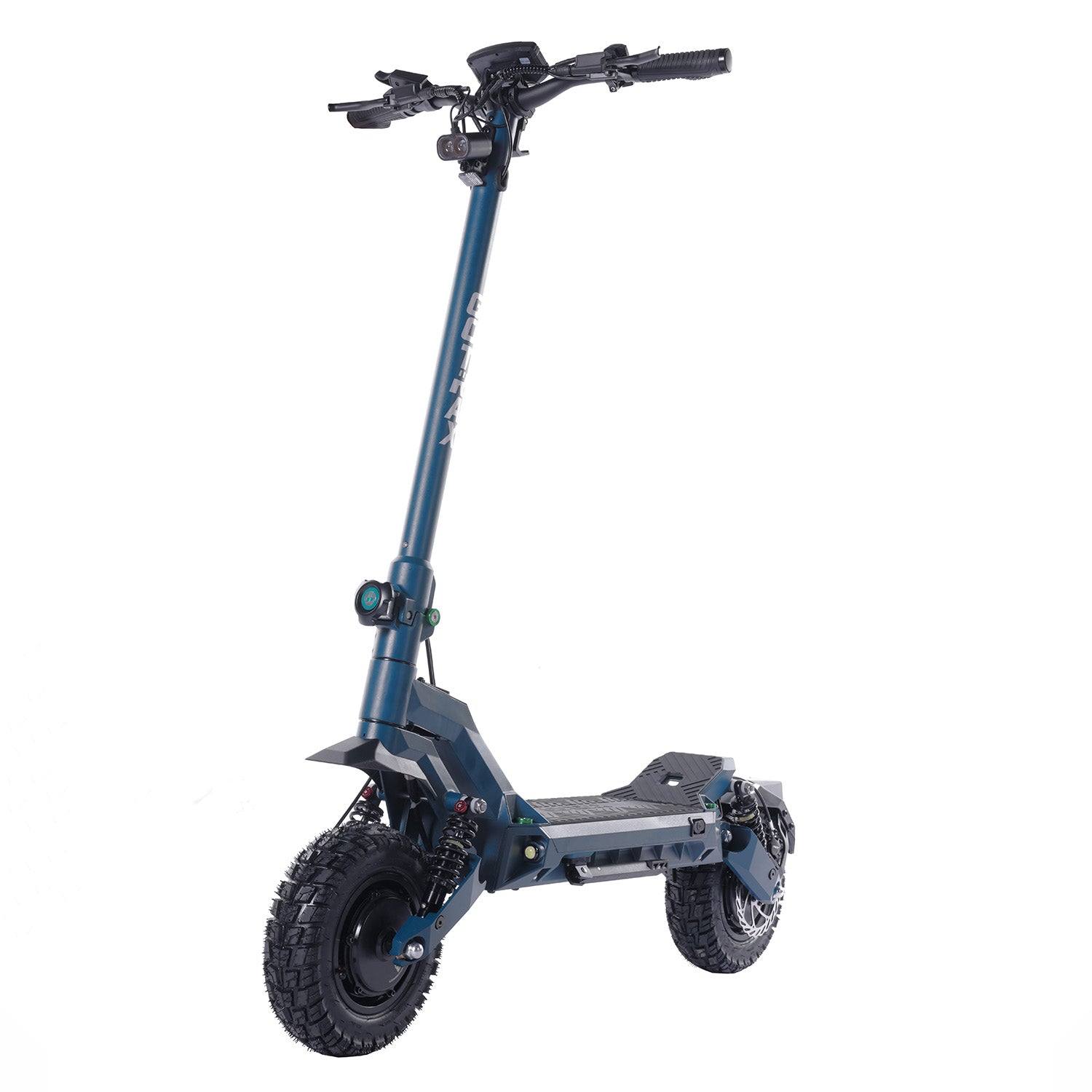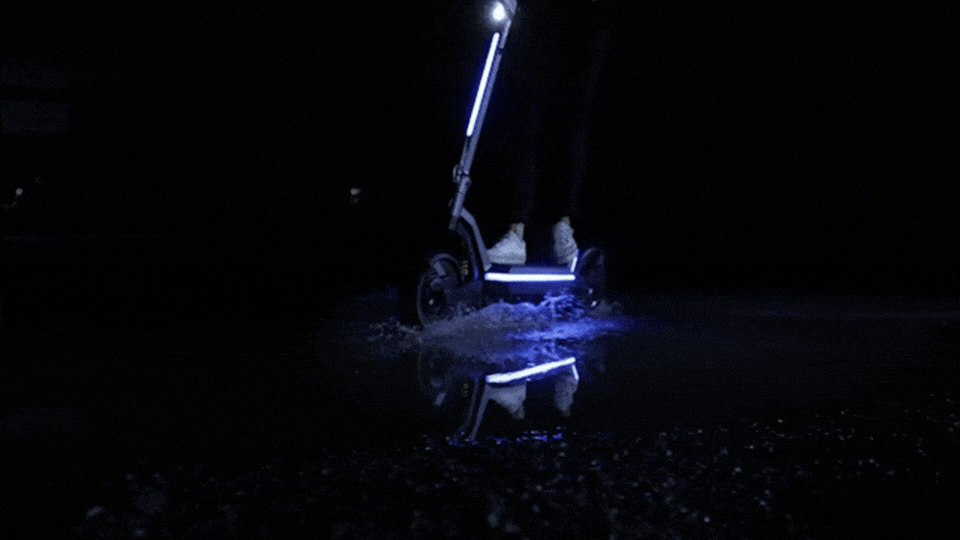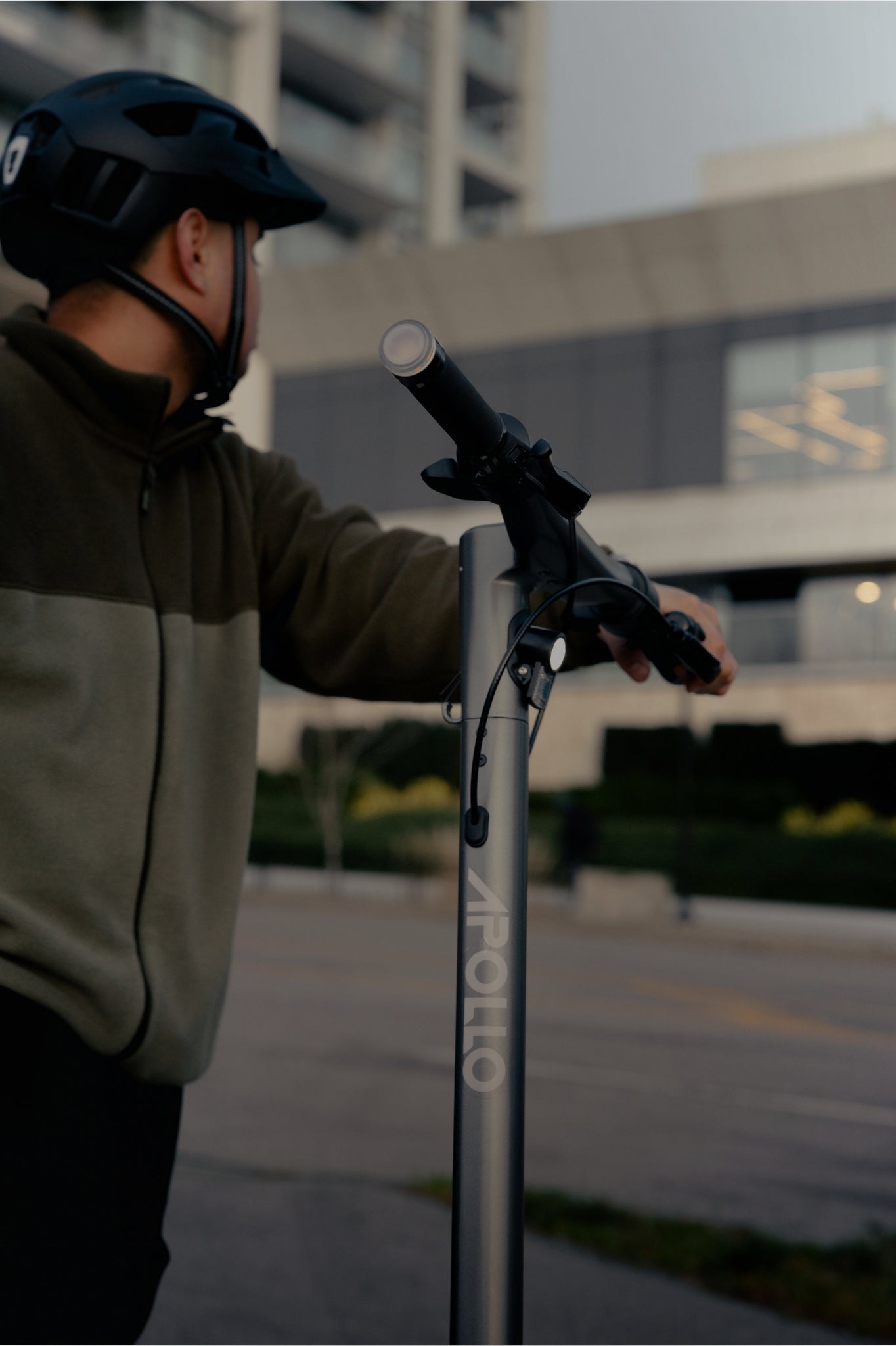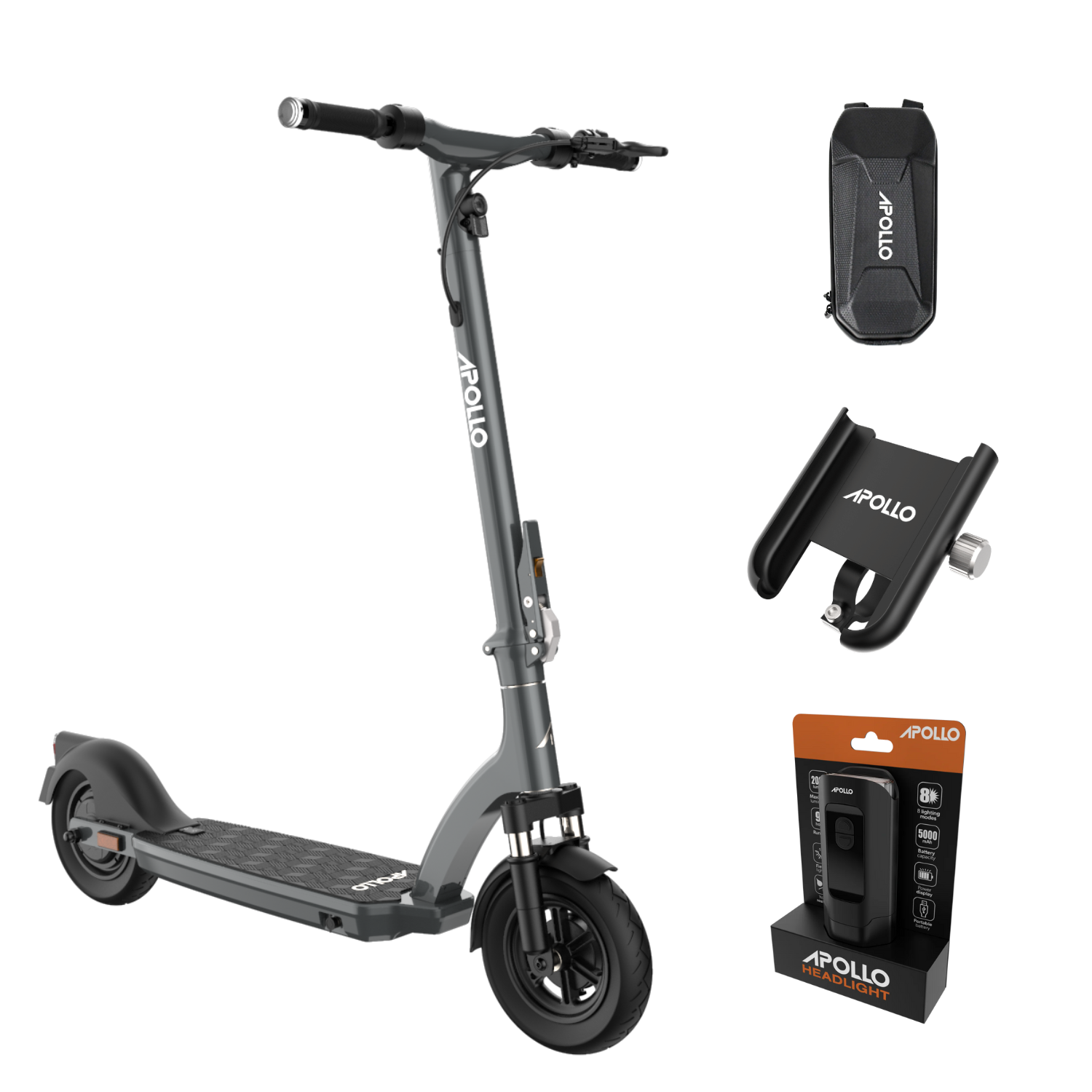We get this question so often. Can I use my scooter in the rain? And while you technically could because no one is going to stop you - it will be at your own risk, because warranties rarely cover water damage.
But we get it - premium electric scooters aren’t cheap and committing to one may be hard if you have to keep it parked every time the weather isn’t great. So, keep reading to learn more about scooters, water, water damage & whether or not you can ride your scooter in the rain.
What Makes an Electric Scooter Waterproof or Water-Resistant?
First off, let’s get things straight. There is no such thing as a waterproof scooter. Like most electronics, electric scooters have different levels of water resistance - and anyone who says otherwise is probably lying.
Wait—does terminology really matter? Actually, yes.
We totally get it—“waterproof,” “water-resistant,” it can all sound like technical fluff. But trust us, this isn’t just semantics. We've seen too many scooters damaged by rain and too many frustrated riders—when it could’ve all been avoided with the right info. Knowing the difference could literally save your scooter. So let’s get into it.
How do you read water resistance ratings?
Water resistance is measured using something called an IP rating—short for Ingress Protection.
Developed by the International Electrotechnical Commission (IEC), this global standard tells you how well a device is sealed against dust and water. You’ve probably seen these ratings before on phones or earbuds, but they apply to electric scooters too. Now that you know what they mean, you’ll be able to confidently choose a scooter (and any other electronic) that’s ready to handle the intended use.
You should probably also know that these ratings are not arbitrary. The IEC also establishes how tests should be done to be able to claim a specific water resistance grade.

How do you read IP ratings?
The IP rating is made up of two numerals, right after the letters “IP”:
-
The first numeral refers to the level of protection against solid objects (dust) and goes from 0 to 6 (6 being the maximum level of protection against dust).
-
The second numeral refers to the protection against water (and any other liquid). In this case the rating goes from 0 to 9 (where 9 is the maximum level of protection).
Wait—what about IPX5 or IPX6? Great question. The “X” simply means the product wasn’t tested for that specific type of protection. So if you see IPX5, it was tested for water resistance but not for dust. Flip it around, and IP5X means dust-tested, but not water-tested. Good to keep this in mind for your next purchase.
What does each IP rating mean?
Finally—what you came here for! Let's decode those mysterious IP ratings. While there are technically 88 different combinations, don’t worry—we’re only listing the most commonly seen ratings in the electric scooter world.
Here’s a quick breakdown, plus examples from leading brands like Segway, Gotrax, and Kaabo:
-
IPX4: Not tested against dust. Protected against splashing water from any direction.
Claimed for: Segway E2 Plus II, Gotrax G3 Max, Gotrax G4 -
IP54: Protected against dust (but remember, there’s still one more level of protection) and water splashing from any direction.
Claimed for: Gotrax GXL V2, Gotrax GX3

-
IPX5: Not tested against dust. Protected against water jets from any direction.
Claimed for: Segway ZT3 Pro -
IPX6: Not tested against dust. Can handle powerful water jets from any direction.
Claimed for: Segway Max G3, Ninebot F3, Segway GT3 -
IP66: Dust tight and can handle powerful water jets from any direction.
Seen on: Apollo Go, Apollo Phantom 2.0, Apollo City.
As for Kaabo, we couldn’t find any officially claimed water resistance ratings—so ride cautiously!
Feel free to check out the International Electrotechnical Commission website for more information.
Why a Water-Resistant Electric Scooter is Essential for Rainy Commutes
Before we jump into it, there are a couple of important things you need to know about water resistance in scooters.
Are Electric Scooters Water-Resistant Forever?
No! Definitely not. The water resistance level claimed by companies is only accurate if the scooter hasn’t been opened or modified. As soon as the factory seals are broken, the scooter loses its water resistance rating—along with any warranty coverage for water damage (if that was included).
Other factors that can impact water resistance include:
-
Big temperature changes: (that’s why we recommend you be extra cautious during summer and store your scooter safely during winter)
Impacts: (crashes, drops, or hard hits can damage the seals) -
And finally... Time!
What About Time?
It’s important to note that all IP ratings are based on exposure for a limited amount of time.
Water resistance levels range from mild drip protection to full immersion. For spray levels (IPX3 and IPX4), tests use water from either an oscillating tube (similar to a garden sprinkler) or a handheld showerhead, delivering water at 12.5 liters per minute. The test duration is at least 3 minutes or, for large units, 1 minute per square meter of surface area as the spray is moved around.
For Level 5, the test uses the same flow rate (12.5 L/min) but through a 6.3 mm nozzle.
Level 6 increases pressure and flow using a 12.5 mm nozzle at 100 liters per minute, from a distance of 2.5 to 3 meters. Exposure time remains 3 minutes. (Source)
Did you catch that? Three minutes. That’s it.
So next time you’re thinking about a 30-mile ride in the pouring rain, consider this: it might sound romantic, but for your scooter, it’s potentially a death sentence.
Can Electric Scooters Be Submerged in Water?

We’re getting closer to our original question: what’s the best electric scooter for a rainy day? But before we go there, let’s be clear about something.
Water resistance ratings mean a scooter can handle some water exposure—for a limited time.
Ever owned a watch with a water-resistance label? If you’re into diving or water sports, you know how those ratings work: they're measured in ATM (atmospheric pressure) and indicate how deep and how long you can submerge them.
What Does This Have to Do With Electric Scooters?
Here’s the deal: electric scooters are NOT designed to be submerged.
IP ratings are meant to give you peace of mind if you hit a puddle or get caught in the rain unexpectedly—but that doesn’t mean they can survive prolonged exposure to water. Especially not if you skip drying them off right after.
If you’ve owned a bike, you know getting it wet isn’t the end of the world—but if you don’t maintain it, rust builds up, parts corrode, and things fall apart. Scooters are no different—except they have electronics inside -so it’s worse!
TL;DR
-
Do NOT submerge your scooter in water.
-
No, your warranty likely won’t cover water damage if you do.
-
IP ratings are only for brief exposure to water jets—about 3 minutes.
-
And no, your scooter isn’t built for wakeboarding (in case that was on your bucket list).
All of this might make it sound like you shouldn’t ride your scooter in the rain at all—so why even rate them, right? The truth is, rain is going to happen. You might not plan to ride in a downpour, but sooner or later, you'll get caught in a drizzle or hit a puddle after a storm. That’s why it’s important to feel confident that your scooter can handle those situations—at least long enough for you to make it to shelter.
So, beyond just the IP rating, there are a few other things we think are worth considering when it comes to water and riding.
Key Features to Look for in Waterproof Electric Scooters
When thinking about water, rain, and water-resistance ratings, there’s more to consider than just the IP number. Here are a few often-overlooked but essential features:
-
Handlebar grip – Will it become slippery when wet? Can you still control the throttle and brakes easily? Poor grip in the rain can quickly turn into a safety issue.
-
Lights – Rainy weather usually means low visibility. Make sure your scooter has bright, reliable front and rear lights so other vehicles and pedestrians can see you clearly.
-
Tires with a strong grip – Wet pavement is no joke. Traction is key, so look for durable tires designed for better control on slippery surfaces - wider tires are usually better.
And finally—it might go without saying—but don’t forget your own rain gear. A good rain jacket, waterproof bag, and dry storage for electronics can make all the difference on a soggy commute.
The Best Electric Scooters from Apollo Scooters
At Apollo Scooters, we take pride in our water-resistance ratings. Our scooters are built to perform in all kinds of weather—and all the models listed below feature an impressive IP66 rating. But of course, we have our favorites:
Apollo Phantom 2.0
Our newest release, designed with the latest technology and insights gathered from all our previous models. It’s built to push boundaries—and yes, it’s IP66 rated.
Apollo Go
Our second-newest scooter is perfect for daily commuting. Compact, reliable, and built tough with an IP66 rating to match.
Apollo City 2024
A fan-favorite for commuting, but also ready for weekend adventures. It strikes the perfect balance between size, performance, and all-weather durability—complete with an IP66 rating.
What to Expect When Riding an Electric Scooter in the Rain
While we don’t recommend riding in the rain—due to the potential risks of water damage and safety concerns like slippery roads or low visibility—sometimes it’s unavoidable. If you do find yourself caught in wet weather, here are some key tips to keep in mind:
Most importantly: riding in the rain requires extra caution.
-
Brake earlier and more gently on wet pavement. Just like when driving a car, stopping distances increase in the rain.
Avoid puddles—they might be deeper than they look and could hide potholes or debris. It’s a real safety hazard. -
Stay visible. Rain reduces visibility for drivers, so make sure you’re using reflectors or high-visibility lights to help others see you.
Caring for Your Waterproof Electric Scooter During Wet Weather
It’s not just about how you ride—it’s also about what you do after the ride. If you get caught in the rain, taking proper care of your scooter afterwards is crucial. Water can sneak into the smallest crevices and cause long-term damage if ignored. So once you’re back home (or wherever you store your scooter):
-
Dry your scooter thoroughly after each rainy ride.
-
Store it indoors, in a dry place, away from moisture.
-
Check your brakes and tire tread regularly.
-
Inspect the charging port and electrical connections for any signs of water intrusion.
Looking for the best waterproof electric scooter for your rainy commute? Browse the latest models at Apollo Scooters and ride with confidence—rain or shine.
Disclaimer: The information provided in this guide is based on publicly available sources and manufacturer claims at the time of writing. While we strive for accuracy, specifications and ratings may change over time. This content is intended for informational purposes only and does not constitute an official recommendation. We encourage you to verify details with the manufacturer and use your own judgment when assessing product suitability and safety.
Waterproof E Scooter FAQs
How do I know if an electric scooter is safe to ride in the rain?
Check the scooter’s IP rating. At a minimum, IP54 is required for light rain, while IP66 or higher is best for regular wet commutes. But remember - it’s only for a limited time- 3 minutes tops - and you need to be sure to dry your scooter completely after it gets wet.
Can I use my electric scooter in heavy rain?
No electric scooter in the market (currently) is completely waterproof, they are only water-resistance. Depending on their individual IP rating, Electric scooters can handle light to moderate rain, heavy downpours can still risk internal damage. It’s best to avoid very heavy rain or standing water for prolonged periods of time.
What makes Apollo Scooters great for rainy weather?
Apollo designs keep in mind that you will inevitably fall in a puddle or get caught in the rain—most of our scooters are IP66 water-resistant, the highest rating currently offered in electric scooters. We also consider grippy tires and bright lighting to make them safer if you end up in a wet situation.
What maintenance do waterproof electric scooters require after riding in the rain?
You must dry them off, check your tires, inspect your charging port, and store them in a dry place. Routine scooter maintenance keeps them reliable year-round.
Are Waterproof Electric Scooters Worth the Investment?
Absolutely, we think high IP rating water-resistant scooters are worth it. If you commute year-round, a waterproof electric scooter gives peace of mind. Over time, they save money on rideshares or public transport—and they’re built to last.






